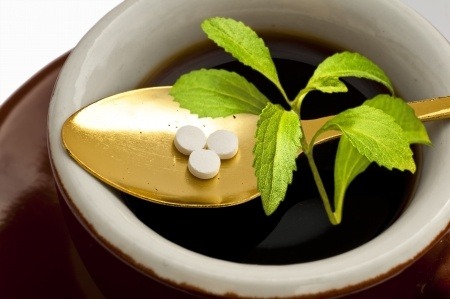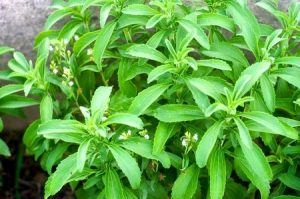
Stevia (Stevia rebaudiana Bertoni; Family: Asteraceae) and its extracted derivatives have long been touted as the next big thing in high-potency sweeteners for product development and there must have been great excitement in supplier quarters with the announcement in the EU of its approval. It has a long history of commercial use in most countries such as the USA, Brazil and Japan, but apart from France, Russia and Switzerland had not yet been accepted by the EU as an ingredient. It should encourage the development of low-calorie or reduced calorie beverages and food products.
Quite properly, toxicological data needed to be assessed which delayed its regulatory approval. The author has worked extensively on its applications in beverages for a few years so its anticipated adoption was exciting news ! That moment finally arrived with approval granted in the EU on the 11th November which meant that it could officially be used from the 3rd December onwards. One thus expects a great range of beverages and foods sweetened with Stevia to enter the marketplace.
The Stevia leaf is where all the sweetness is contained but as a commercial ingredient, extracts are made to concentrate this sweetness. The sweet components are mainly the diterpene glycosides, Rebaudiosides A (reb A) to F, Dulcoside A, Stevioside and the aglycone Steviol which are all commercially extracted from its leaves. There are 10 in all although there may still be some small undiscovered molecules related to steviol to be found. Each has differing levels of sweetness intensity and aftertaste which has an important bearing on its application. Generally, stevia is 250 to 300 times sweeter compared to sucrose although Rebaudioside A is claimed to be up to 400 times sweeter.
What else could be present in Stevia leaves which add to the flavour, especially that causing bitterness? Using a combination of liquid-solid chromatography, capillary GLC and mass spectrometry, the essential oil obtained by steam distillation from the dried leaves of Stevia rebaudiana was analysed (Martelli et al., 1985). Caryophyllene oxide and spathulenol accounted for about 43% of the oil, which contained more than a hundred compounds, most of which were present only in traces and 54 components were identified. Subsequently, the essential oil composition of the aerial parts of five different Stevia rebaudiana genotypes cultivated in Tuscany coast (Italy) were examined by GC and GC/MS. Forty different components were identified and the main constituents in all studying samples were spathulenol (13.4–40.9%), caryophyllene oxide (1.3–18.7%), β-caryophyllene (2.1–16.0%) and β-pinene (5.5–21.5%) (Cioni et al., 2006).
From a nutrition point of view, Stevia and its components are zero calorie although the sugar moieties have a small calorific value. Given it is sweeter by nearly 400 times that of sucrose, the amounts needed in an application should be relatively small.
The benefits are huge. Stevia is an alternative to artificial high intensity sweeteners (HIS) and will probably be classed as natural if the leaf only is used. The components themselves could not be described as ‘natural’ as a certain degree of processing is required to extract them.
There is an ever increasing number of suppliers so choice is important at this moment in time because a wide range and quality of stevia and its extracts are available. If the individual components are used the regulatory phrasing will state claims such as ‘sweetener from natural sources’.

The plant Stevia rebaudiana (Bertoni) which originally came from Paraguay can be grown in the UK but is not frost hardy and requires relatively wet conditions. Plants in the greenhouse need constant watering and I treat it rather like Basil – watering only before lunchtime. It’s not a beauty either but given it resembles a small aster flower it has potential to be a useful herb. Given this is the first time I’ve grown the plant, I will treat it like Tarragon and grow it in a ceramic pot before transferring to the greenhouse for Winter. An alternative would be to protect in a cold frame and cover with bracken if the plant is taken by frost. My aim would certainly be to grow a frost hardy version which may be possible. Commercially, the plant is widely grown in South America, China, South-East Asia and India.
One of the concerns that Stevia presents is the nature of the aftertaste. This has invariably been described as ranging from liquorice to sanitising soap. The perception depends on the purity of the product, the other ingredients used, especially fruit juices in beverages for example and whether specifically added masking agents are available. It doesn’t work well in baked goods where it tends to breakdown over time, especially in the oven.
Stevia sweetener itself is available in both powder and liquid forms and can be bought as Truvia ® and PureVia®. The suppliers of stevia extracts are differentiating themselves by the level of reb-A in their product. Mane for example offer quite a range of stevia extracts and are worth exploring. This author has been working on various beverage product types to exploit the sweetness of Stevia and Rebaudioside. There are certain fruit types and masking agents which are suitable for use and any issues which arise from the taste can be overcome.
References
, P.L. , I., , L., , M., , L. (2006) Qualitative and Quantitative Analysis of Essential Oils of Five Lines Stevia rebaudiana Bert. Genotypes Cultivated in Pisa (Italy). J. Essential Oil Research, 18, (1) pp. 76
Martelli, A., Frattini, C. and Chialva, F. (1985), Unusual essential oils with aromatic properties—I. Volatile components of Stevia rebaudiana bertoni. Flavour Fragr. J., 1: pp. 3–7. doi: 10.1002/ffj.2730010103

Leave a Reply